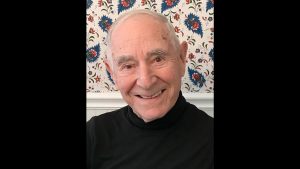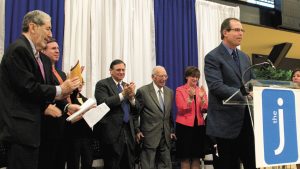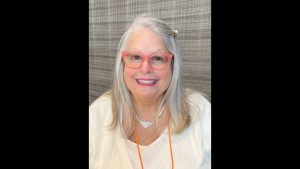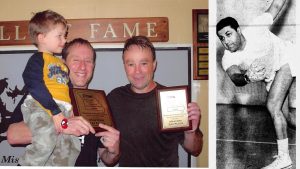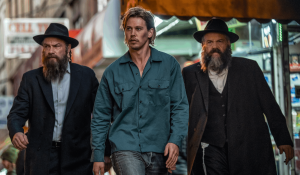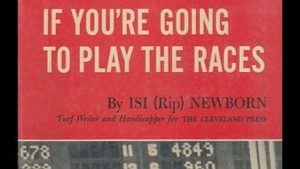A Black writer explores how U.S. and Germany differ in remembering their pasts
Published November 29, 2022
(JTA) — For his 2021 book “How the Word Is Passed,” winner of the National Book Critics Circle Award for Nonfiction, poet and journalist Clint Smith explored the landscape of American memory — specifically how the history of slavery is explained, commemorated, distorted and desecrated in sites across the United States.
While on tour promoting the book, he explained in an interview Tuesday, he’d often be asked if any country had gotten it right when it came to memorializing its own dark past. “I kept invoking the memorials in Germany, but I had never been to the memorials in Germany,” Smith said. “As a scholar, as a journalist, I felt like I had to do my due diligence and excavate the complexity and the nuance, and the emotional and human texture, that undergirds so many of these places and spaces.”
The result is December’s cover story in the Atlantic, “Monuments to the Unthinkable.” Smith traveled to Germany twice over the past two years, visiting Berlin’s Memorial to the Murdered Jews of Europe, its Topography of Terror Museum, the museum in Wannsee where the Nazis plotted the Final Solution, and the concentration camp at Dachau, talking to historians and curators along the way. As a Black man wrestling with how America accounts for the crimes of its past, he went to learn from the experience of the Germans, who “are still trying to figure out how to tell the story of what their country did, and simultaneously trying to figure out who should tell it.”
ADVERTISEMENT
In an interview, Smith talked about the inevitable differences between the Holocaust and the Atlantic slave trade, the similarities in how two countries — and communities — experience their histories, and how his article could serve as a bridge between African-Americans and Jews in a time of increasing tension between them.
Smith spoke to JTA from his parents’ home in his native New Orleans.
This interview was edited for length and clarity.
Jewish Telegraphic Agency: Your book is about the ways America succeeds and fails to come to terms with slavery, and your article is about the ways Germany is, in your phrase, “constructing public memory.” I was struck by someone who warned you, “Don’t go to Auschwitz.” What were they saying?
Clint Smith: It was Frederick Brenner, a Jewish man and a remarkable photographer who has photographed the Jewish Diaspora across the world for the past several decades, who said that, because people are standing [at Dachau] and they’re taking selfies, and it’s like “me in front of the crematorium” and “me in front of the barracks.” That was deeply unsettling to him, especially as someone whose family was largely killed in the Holocaust.
ADVERTISEMENT
I don’t want to be reductive about it and say that you don’t want people to go to these spaces and take pictures. I think it’s all about the sort of disposition and sensibilities one brings to a space. If someone went to the Whitney Plantation in Louisiana, I don’t necessarily want them doing puckered-lip selfies in front of a slave cabin. I can understand why people wouldn’t want those places engaged with in that way, but you do want tourists to come, right? I mean, before the pandemic, 900,000 people visited Dachau every year, and part of what brings people to Dachau is seeing and taking a picture of the crematorium, taking a picture of themselves on this land in that space where history happened, and posting it online. And maybe that serves as a catalyst for somebody else to make that journey for themselves.
You did go to Dachau, which you call a “memorial to the evil that once transpired there.”
I am a huge believer in putting your body in the place where history happened. I stood in many places that carry the history of violence: plantations, execution chambers, death row. But I’ve never experienced the feeling in my body that I felt when I stood in the gas chamber at Dachau. And you just see the way that this space was constructed, with the sort of intentional, mechanized slaughter that it was meant to enact on people. The industrialized nature of it was something unlike anything I’d ever experienced before and it made me feel so much more proximate to that history in ways that I don’t think I would have ever experienced otherwise.
Physically standing in a concentration camp and physically standing and putting my body in the gas chamber fundamentally changed my understanding of the emotional texture and the human and psychological implications of it. Because when you’re in those spaces you’re able to more fully imagine what it might have been like to be in that space. And then you can imagine these people, these families, these women, these children who were marched into camps throughout Europe. You can never fully imagine the fear, that sense of desperation that one would have felt, but in some ways, it’s the closest we can get to it if you are someone who did not have family who lived through or survived the Holocaust. It provided me with a radical sense of empathy. And that’s why I took the trip in the first place.
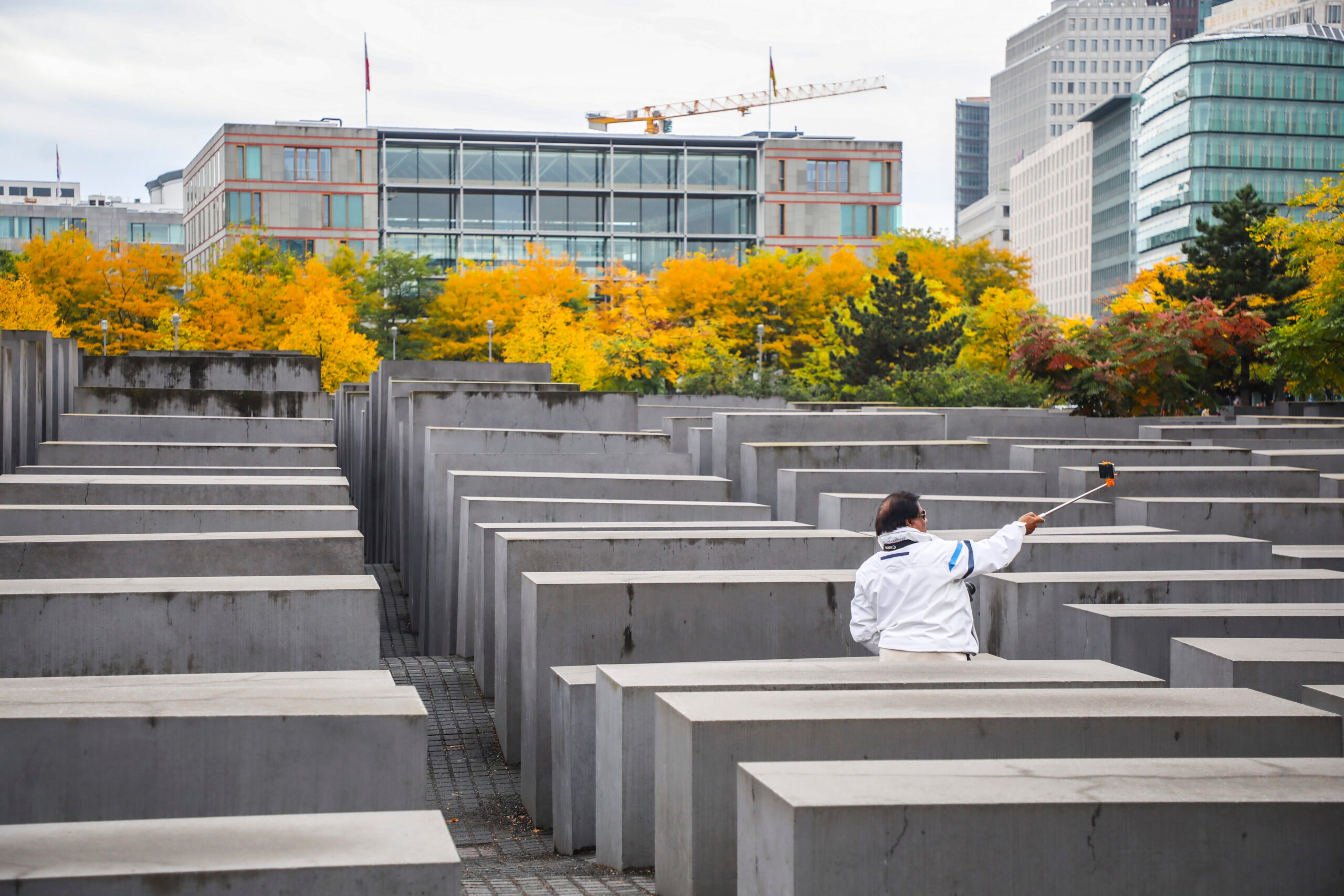
By contrast, there are the memorials that are not historical sites, but either sculptural or architectural, like Berlin’s Memorial to the Murdered Jews of Europe, nearly five acres of concrete slabs. What do you think makes an effective memorial that isn’t necessarily the historical place itself, but a specifically memorial project?
Well, for example, the big one in Berlin. It’s just so enormous. The scale and scope of it was unlike anything I’d ever seen before. I tried to imagine what an American analog would be like. What if in the middle of downtown Manhattan there was a 200,000-square-foot memorial, with thousands of stone columns, dedicated to commemorating the lives of indigenous people who were killed in the early Americas? Or a 200,000-square-foot memorial in the middle of downtown D.C., not far from the White House, to the lives of enslaved people?
With that said, what I found really valuable were the people I spoke to, who had very different relationships to that space. Some thought of that memorial as something that was so meaningful because of its size and because of its scope, and because it was a massive state-sanctioned project. And then there were others who thought that it was too abstract, that it was too passive, even in its name, right, the “Memorial to the Murdered Jews of Europe,” which sounds as if something happened to people without naming the people who enacted the harm and who committed the crime. Those are the sort of nuances and complexities that I wanted to spend more time with, and found really valuable because, in the same way, descendants of enslaved people here in the United States have many different conceptions of what the iconography of slavery should look like or what repair and reparations to slavery should be made.
You write about the “stumbling stones” or “Stolpersteine”: Those are the small brass plaques placed in the streets, inscribed with the names of Holocaust victims and placed in front of their last known residence. The stones are exactly the opposite scale of the Berlin memorial.
Right. I think that is the memorial that I was most struck by: the largest decentralized memorial in the world, with 90,000 stones across 30 different European countries. I remember the moment I was walking down the street looking for landmarks and saw my first Stolpersteine, and I only saw it because at that moment the clouds moved and the sun shone off the brass stone. You see the name, the birth date, the deportation date, the death date, the place where the person was killed. You walk past another home, you see seven; you walk past another home, you see 12. You begin to imagine entire lives based on the names and information that exist on these stones. It creates this profound sense of intimacy, this profound sense of closeness to the history and it’s so human, because it’s individual people and individual names.
One of the most valuable things about the stumbling stone project, I think, is all the work that precedes it. It’s the school students who are doing research to find out about the lives of the people who were taken from the home across the street from their school. It’s the people in the apartment complex, who come together and decide that they’re going to figure out who were the Jewish families who lived in that apartment complex before them. And sometimes it’s really remarkable, granular details about people’s lives: what their favorite food was, what their favorite flavor of ice cream was, what the child liked.
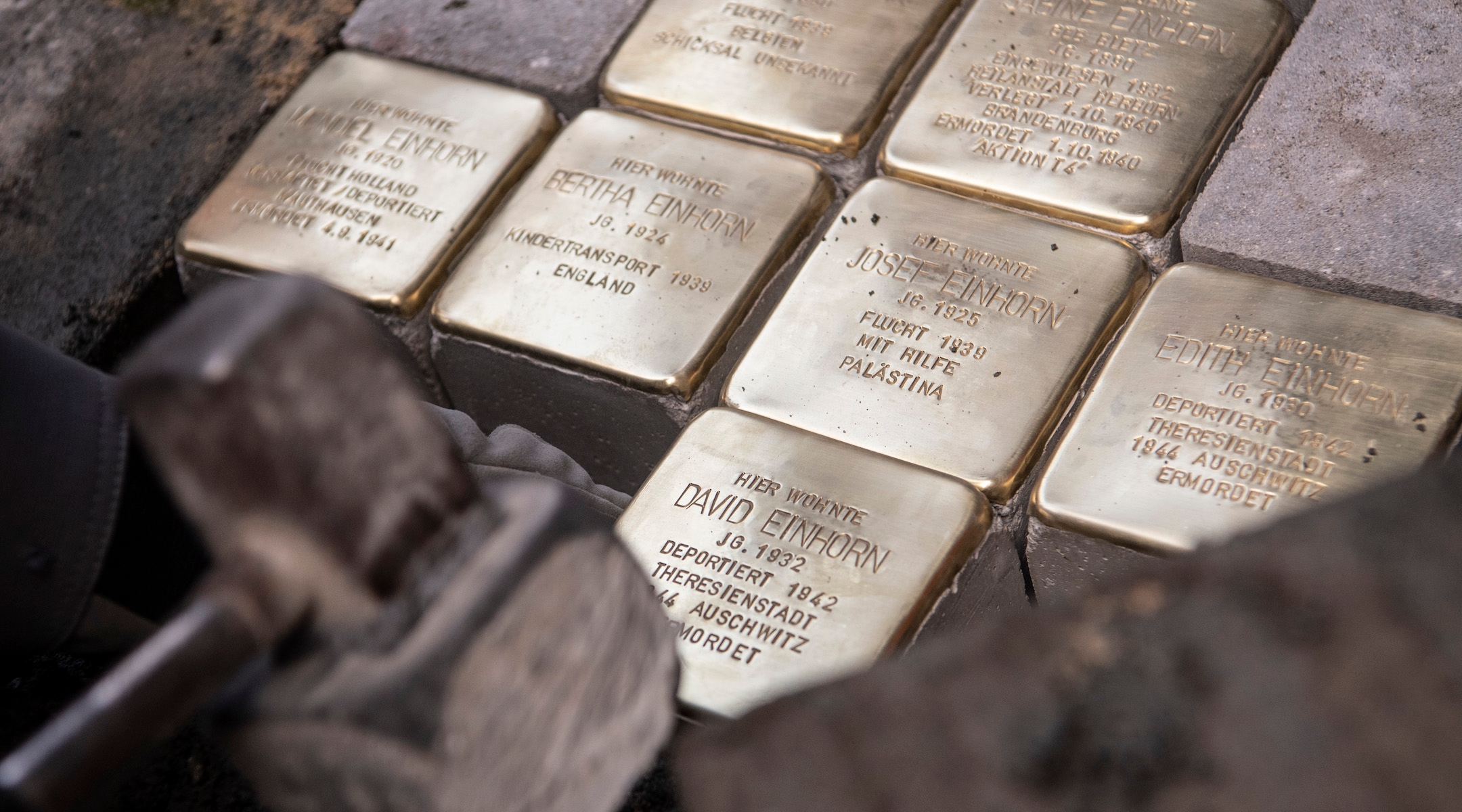
As Gunter Demnig, the originator of the project, says, 6 million people is a huge abstraction, and now it becomes about one man, one woman, one child, and [people] realize that it truly was not that long ago. There are so many survivors of the Holocaust who are still with us. Gunter Demnig, his father fought for the German army. He represents this generation of people who are engaging in a sort of contrition for the acts of their parents and their grandparents.
You ask in the piece what it would look like for a similar project to be created in the United States as a memorial to enslaved people.
I’m from New Orleans, and the descendant of enslaved people in New Orleans, which was at one point the busiest slave market in the country. And as Barbara Steiner, a Jewish historian, said to me in Germany, entire streets [of New Orleans] would be covered in brass stones! That was such a striking moment for me. That helped me more fully realize the profound lack of markers and iconography and documentation that we have to enslaved people in our landscape here in the United States relative to that of Germany.
Why are physical monuments important? I have sometimes wondered why we spend so much money on the infrastructure of memory — statues, museums, memorials — and if that money could be better used for living memorials, like scholarships for the descendants of victims, say, or programs that study or archive evidence of genocide. Why is it important to see a statue or a museum or even a plaque?
First off, museums and statues and memorials and monuments are by no means a panacea. It is not the case that you put up some memorials or you lay down some Stolpersteine and suddenly antisemitism is gone. Obviously, Germany is a case study and is experiencing its own rise in antisemitism. And that’s something that’s deeply unsettling, and is not going to singularly be solved by memorials and monuments.
With that said, I think there is something to be said to regularly encounter physical markers and manifestations of the violence that has been enacted and crimes that have been done in your name, or to the people that you are the descendant of. I try to imagine Germany without any of these memorials and I think it would just be so much easier for antisemitism to become far more pervasive. Because when your landscape is ornamented by things that are outlining the history that happened there, it is much more difficult to deny its significance, it is much more difficult to deny that it happened, it is much more difficult not to have it shape the way you think about public policy. I do believe that if we had these sorts of markers in the United States, it wouldn’t solve the racial wealth gap, it wouldn’t solve racism, it wouldn’t solve discrimination. It wouldn’t eradicate white nationalism or white supremacy. But I do think it would play some role in recalibrating and reshaping our collective public consciousness, our collective sense of history in ways that would not be insignificant.
And to your point, my hope is that those things are never mutually exclusive. It’s a conversation that’s happening here in the United States with regard to how different institutions are accounting for their relationship to slavery. Universities are coming up with reports, presentations, panels and conferences that outline their relationship to the history of slavery, especially since the murder of George Floyd [in 2020]. Activists and descendants have pushed them to not just put out a report, or put up a plaque or make a monument. It’s also about, well, what are you going to do for the descendants of those people? Harvard, where I went to grad school, put $100 million aside specifically for those sorts of interventions. Places like Georgetown have made it so that people who were the descendants of those who are enslaved have specific opportunities to come to the school without paying. And people of good faith can disagree over whether those initiatives are commensurate with or enough to atone for that past, and I think the answer is almost inevitably no.
Certainly people on what we like to think of as the wrong side of history understood the importance of physical monuments in creating memory.
The origin story of my own book was that I watched the monuments come down in 2017, in my hometown in New Orleans, of Jefferson Davis, Robert E. Lee. I was thinking about what it meant that I grew up in a majority Black city, and there were more homages to enslavers than there were to enslaved people. What does it mean that to get to school I had to go down Robert E. Lee Boulevard? That to get to the grocery store, I had to go down Jefferson Davis Parkway? That my middle school was named after a leader of the Confederacy? And that my parents still live on a street today named after someone who owned 115 enslaved people? The names and iconography are reflective of the stories that people tell and those stories shaped the narratives that communities carry. And those narratives shape public policy and public policy is what shapes the material conditions of people’s lives.
One thing about Germany is that its national project of memory and repentance has been accompanied by a vast reparations program — for Israel, Jewish survivors, their families and programs to propagate Jewish culture. I wonder if you think Germany could have moved ahead without reparations? And can America ever fully grapple with the legacy of slavery without its own reparations?
The short answer is no. America cannot fully move forward from its past without reparations. The important thing is not to be limited and reductive in the way that we conceive of what reparations are or should look like. In some ways, I’m as interested if not more interested in what specific cities and states are doing in order to account for those histories and those crimes. For example, in Evanston, Illinois, they created a specific program to give reparations to Black families who experienced housing segregation, in a certain period of time, given how prevalent redlining was in and around Chicago in the mid-20th century. I know in Asheville, North Carolina, there’s a similar program that’s thinking about how to meaningfully engage in repair to the descendants of communities that were harmed from some of the policies that existed there. This is not to say that those programs themselves are perfect. But I think we sometimes talk about it so much on a federal level, that we forget the local opportunities that exist.
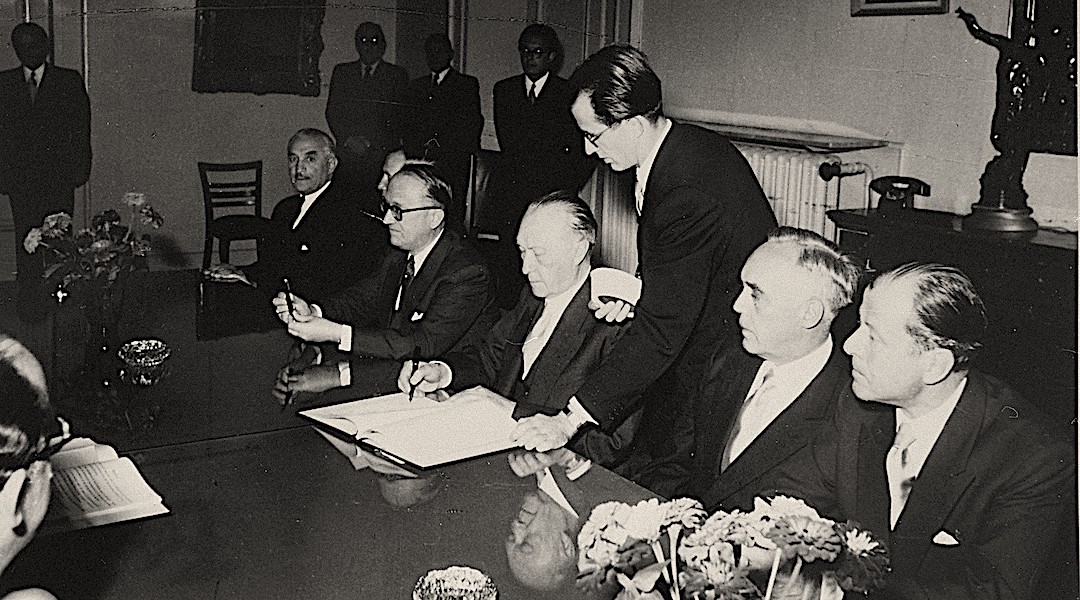
Many people who were redlined or experienced housing covenants — all the sort of insidious manifestations of wealth extraction that were part of Jim Crow — are still alive today. So sometimes it’s not even a question of what you have to give the descendants. Sometimes it’s like, what do you give the actual people who are still here?
That’s an important distinction you make in your article, about the difference between grappling with the past in Germany and the United States. In Germany, there are so few Jews, while in the U.S. we see the living evidence of slavery, not the evidence of absence.
That’s perhaps the greatest difference that allows for both a landscape of memory to be created in Germany, and also allows for Germany to pay reparations in ways that the United States is reluctant to do: Jewish people in Germany represent less than one quarter of one percent of the population of Germany. One of the folks I spoke to told me that Jewish people in Germany are a historical abstraction. Because there’s so few Jewish people left, because of the slaughter of the Holocaust. I think about the reparations that were given to Japanese Americans who were held in incarceration camps during World War II. They got $20,000 checks, which is not commensurate with what it means to be held in a prison camp for multiple years, and cannot totally atone for that. But part of the reason that can be enacted is that there’s a limited amount of people. There are 40 million black people in this country. So the economic implications of reparations are something fundamentally different here in the United States.
So let me ask you if there’s anything else you wanted to mention that we haven’t talked about.
I want to name specifically for your readers that I’m not and would never intend to conflate slavery and the Holocaust. They are qualitatively different historical phenomena that have their own specific complexities and should be understood on their own terms. With that said, I do think it can be helpful to put the two in conversation with one another, specifically in the profound ways that these two monumental periods of world history have shaped the modern world and how they are remembered in fundamentally different ways.
And there are similarities as well, which you write about.
I did find so many parallels. The Jewish people I spent time with in Germany explained that some of the manifestations of racism and anti-Blackness in the United States are not so different from the sort of manifestations of antisemitism that exist in Germany, especially as it relates to public memory. When I was at the museum devoted to the Wannsee conference, the executive director, Deborah Hartmann, told me that she and Deidre Berger [the chair of the executive board of the Jewish Digital Cultural Recovery Project Foundation] were talking about how Jewish people did not always have a seat at the table when these monuments and memorials were being built. Jewish people were not allowed to participate beyond a certain extent, because many Germans felt that Jewish people were not objective. Jewish historians couldn’t be taken seriously because they were too close to the history.
That just echoes so much of what Black scholars and historians have been told about their ability, or the lack thereof, to study the history of Black life. The godfather of African-American scholarship, W.E.B. Du Bois, was told by white scholars that he couldn’t be taken seriously because he was too close to the history of slavery.
Meanwhile, Deborah Hartmann talked about how so many of the historians and scholars who played a role in shaping the landscape of memory in Germany were themselves “close to the history,” including former members of the Hitler Youth.
Somebody sent me a message that really meant a lot to me this past week, basically saying that my essay is an exercise in “solidarity via remembrance” — in a moment where, unfortunately, there have been a lot of public manifestations of ideas and antisemitic remarks that might threaten to rupture a relationship between Black and Jewish people. Obviously, we didn’t time it this way: I worked on this piece for a year. But it’s my hope that as someone who is a Black American, who is the descendant of enslaved people, who is not himself Jewish — that my respectful, empathic, curious, journey reflects the long history of solidarity that has existed across Black and Jewish communities and that that I hope we never lose sight of.
—
The post A Black writer explores how Germany remembers its ‘unthinkable’ past appeared first on Jewish Telegraphic Agency.





